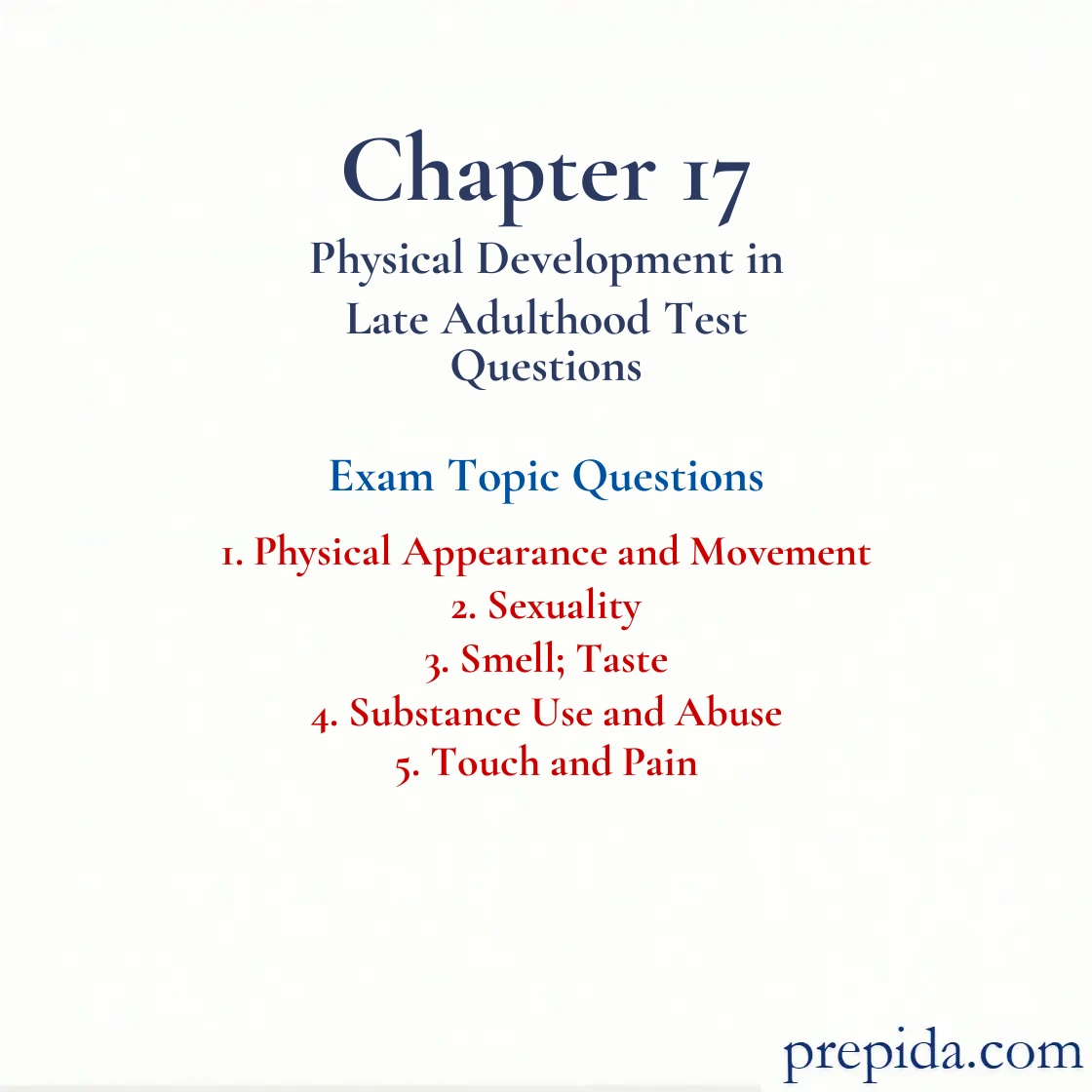
Ruth and Gerald are a married couple. Both are in their late 60s. It is likely that as they get older, ________.
- both Ruth and Gerald will get shorter
- Gerald will get shorter, but Ruth will not get shorter
- Ruth will get shorter, but Gerald will not get shorter
- only if Ruth or Gerald has osteoporosis, he or she will get shorter
________ are the most noticeable changes in physical appearance in late adulthood.
- Loss of hair and brittle nails
- Osteoporosis and osteoarthritis
- Reduction in height and weight
- Wrinkles and age spots
Ageism: Prejudice against others because of their age, especially prejudice against older adults.
Tara is 68 years old. In terms of percentage of total weight, which of following is most likely to increase in her late adulthood?
- muscle
- bone density
- fat
- t cells
Kevin is 60 years old. What should he do to delay the onset of physical disability?
- He should avoid strength training.
- He should walk regularly.
- He should follow a high-fat diet.
- He should ensure that his body mass index (BMI) is above 30.
Aerobic Exercise: Sustained exercise (such as jogging, swimming, or cycling) that stimulates heart and lung activity.
For older adults with a partner who reported not having sex, the main reason was
- poor physical health.
- depression.
- lack of privacy.
- lack of interest.
Chronic Disorders: Disorders that are characterized by slow onset and long duration. They are rare in early adulthood, increase during middle adulthood, and become common in late adulthood.
Which of the following is true of the effects of aging on human sexual performance?
- Orgasm becomes less frequent in females with age, occurring in every second to third attempt rather than every time.
- More direct stimulation usually is needed to produce an erection.
- A large-scale study of individuals from 57 to 85 years of age revealed that sexually active life expectancy was longer for women than for men.
- Women lost more years of sexually active life due to poor health than men did.
Erectile Dysfunction (ED): The inability to adequately achieve and maintain an erection to attain satisfactory sexual performance.
Which of the following is a major challenge for sexually interested older women (70 years or older)?
- male partner's physical health
- lack of sex education
- physical health of older women
- not having a partner
Attachment: A close emotional bond between two people.
Which of the following statements is true of smell and taste in the elderly?
- There is no sign of decline in these senses as we age.
- Older adults show a greater decline in their sense of taste than in their sense of smell.
- Smell and taste decline less in healthy older adults than in their less healthy counterparts.
- Smell and taste become more sensitive as we age.
Stuart is 67 years old, widowed, and lives alone. Recently, he has started drinking too much and frequently engages in binge drinking. Stuart's example presents a case of
- geriatric alcoholism.
- manic depressive alcoholism.
- late-onset alcoholism.
- relapse alcoholism.
Evidence is increasing that ________ plays a key role in red wine's health benefits.
- resperidol
- rohypnol
- resveratrol
- rogaine
Which of the following is true of substance abuse?
- In 2010, the percentage of individuals who engaged in binge drinking increased considerably in the middle and late adulthood years.
- Substance abuse among older adults is an "invisible epidemic" in the United States.
- The frequency of binge drinking (defined as four or more drinks for women and five or more drinks for men on one occasion in the past 30 days) was lowest among older adults.
- Screening questionnaires are appropriate for eliminating substance abuse among older adults.
Addiction: A pattern of behavior characterized by an overwhelming involvement with using a drug and a preoccupation with securing its supply.
Alex is 70 years old. Which of the following areas of his body will be less sensitive to touch?
- wrists
- ankles
- shoulders
- elbows
Which of the following is true of changes in touch and pain sensitivity in older adults?
- The most frequent pain complaints of older adults are back pain, peripheral neuropathic pain, and chronic joint pain.
- With aging, individuals could detect touch less in the upper extremities than in the lower extremities.
- Older adults are more sensitive to pain than are younger adults.
- Increased sensitivity to pain can help older adults cope with disease and injury.
Chronic Disorders: Disorders that are characterized by slow onset and long duration. They are rare in early adulthood, increase during middle adulthood, and become common in late adulthood.